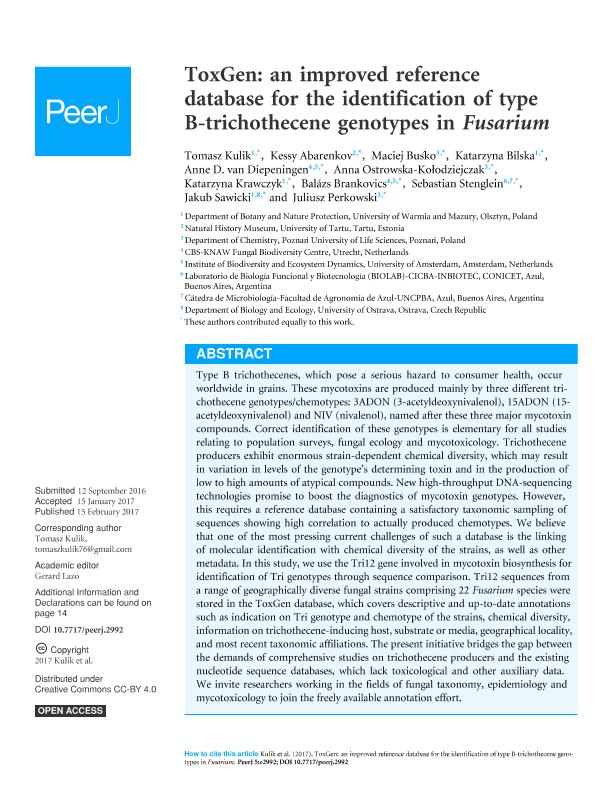Mostrar el registro sencillo del ítem
dc.contributor.author
Kulik, Tomasz
dc.contributor.author
Abarenkov, Kessy
dc.contributor.author
Busko, Maciej
dc.contributor.author
Bilska, Katarzyna
dc.contributor.author
van Diepeningen, Anne D.
dc.contributor.author
Ostrowska-Kolodziejczak, Anna
dc.contributor.author
Krawczyk, Katarzyna
dc.contributor.author
Brankovics, Balázs
dc.contributor.author
Stenglein, Sebastian Alberto

dc.contributor.author
Sawicki, Jakub
dc.contributor.author
Perkowski, Juliusz
dc.date.available
2017-12-14T15:16:02Z
dc.date.issued
2017-02
dc.identifier.citation
Kulik, Tomasz; Abarenkov, Kessy; Busko, Maciej; Bilska, Katarzyna; van Diepeningen, Anne D.; et al.; ToxGen: An improved reference database for the identification of type B-trichothecene genotypes in Fusarium; PeerJ Inc; Peer J; 2017; 2; 2-2017; 1-19
dc.identifier.issn
2167-8359
dc.identifier.uri
http://hdl.handle.net/11336/30587
dc.description.abstract
Type B trichothecenes, which pose a serious hazard to consumer health, occur worldwide in grains. These mycotoxins are produced mainly by three different trichothecene genotypes/chemotypes: 3ADON (3-acetyldeoxynivalenol), 15ADON (15-acetyldeoxynivalenol) and NIV (nivalenol), named after these three major mycotoxin compounds. Correct identification of these genotypes is elementary for all studies relating to population surveys, fungal ecology and mycotoxicology. Trichothecene producers exhibit enormous strain-dependent chemical diversity, which may result in variation in levels of the genotype´s determining toxin and in the production of low to high amounts of atypical compounds. New high-throughput DNA-sequencing technologies promise to boost the diagnostics of mycotoxin genotypes. However, this requires a reference database containing a satisfactory taxonomic sampling of sequences showing high correlation to actually produced chemotypes. We believe that one of the most pressing current challenges of such a database is the linking of molecular identification with chemical diversity of the strains, as well as other metadata. In this study, we use the Tri12 gene involved in mycotoxin biosynthesis for identification of Tri genotypes through sequence comparison. Tri12 sequences from a range of geographically diverse fungal strains comprising 22 Fusarium species were stored in the ToxGen database, which covers descriptive and up-to-date annotations such as indication on Tri genotype and chemotype of the strains, chemical diversity, information on trichothecene-inducing host, substrate or media, geographical locality, and most recent taxonomic affiliations. The present initiative bridges the gap between the demands of comprehensive studies on trichothecene producers and the existing nucleotide sequence databases, which lack toxicological and other auxiliary data. We invite researchers working in the fields of fungal taxonomy, epidemiology and mycotoxicology to join the freely available annotation effort.
dc.format
application/pdf
dc.language.iso
eng
dc.publisher
PeerJ Inc
dc.rights
info:eu-repo/semantics/openAccess
dc.rights.uri
https://creativecommons.org/licenses/by/2.5/ar/
dc.subject
Annotation
dc.subject
Chemotypes
dc.subject
Fusarium
dc.subject
Molecular Identification
dc.subject
Trichothecene Genotypes
dc.subject.classification
Otras Ciencias Biológicas

dc.subject.classification
Ciencias Biológicas

dc.subject.classification
CIENCIAS NATURALES Y EXACTAS

dc.subject.classification
Ciencias de la Computación

dc.subject.classification
Ciencias de la Computación e Información

dc.subject.classification
CIENCIAS NATURALES Y EXACTAS

dc.title
ToxGen: An improved reference database for the identification of type B-trichothecene genotypes in Fusarium
dc.type
info:eu-repo/semantics/article
dc.type
info:ar-repo/semantics/artículo
dc.type
info:eu-repo/semantics/publishedVersion
dc.date.updated
2017-10-11T15:11:26Z
dc.journal.volume
2017
dc.journal.number
2
dc.journal.pagination
1-19
dc.journal.pais
Reino Unido

dc.journal.ciudad
Londres
dc.description.fil
Fil: Kulik, Tomasz. Uniwersytet Warminsko-mazurski W Olsztynie;
dc.description.fil
Fil: Abarenkov, Kessy. University Of Tartu.; Estonia
dc.description.fil
Fil: Busko, Maciej. Poznań University of Life Sciences; Polonia
dc.description.fil
Fil: Bilska, Katarzyna. University of Warmia and Mazury; Polonia
dc.description.fil
Fil: van Diepeningen, Anne D.. University of Amsterdam; Países Bajos
dc.description.fil
Fil: Ostrowska-Kolodziejczak, Anna. Poznań University of Life Science; Polonia
dc.description.fil
Fil: Krawczyk, Katarzyna. University of Warmia and Mazur; Polonia
dc.description.fil
Fil: Brankovics, Balázs. CBS-KNAW Fungal Biodiversity Centre; Países Bajos. University of Amsterdam; Países Bajos
dc.description.fil
Fil: Stenglein, Sebastian Alberto. Consejo Nacional de Investigaciones Científicas y Técnicas. Centro Cientifico Tecnolológico Mar del Plata. Instituto de Investigaciones en Biodiversidad y Biotecnología. Laboratorio de Biología Funcional y Biotecnología; Argentina
dc.description.fil
Fil: Sawicki, Jakub. University of Warmia and Mazury; Polonia
dc.description.fil
Fil: Perkowski, Juliusz. Poznań University of Life Sciences; Polonia
dc.journal.title
Peer J
dc.relation.alternativeid
info:eu-repo/semantics/altIdentifier/doi/http://dx.doi.org/10.7717/peerj.2992
Archivos asociados
